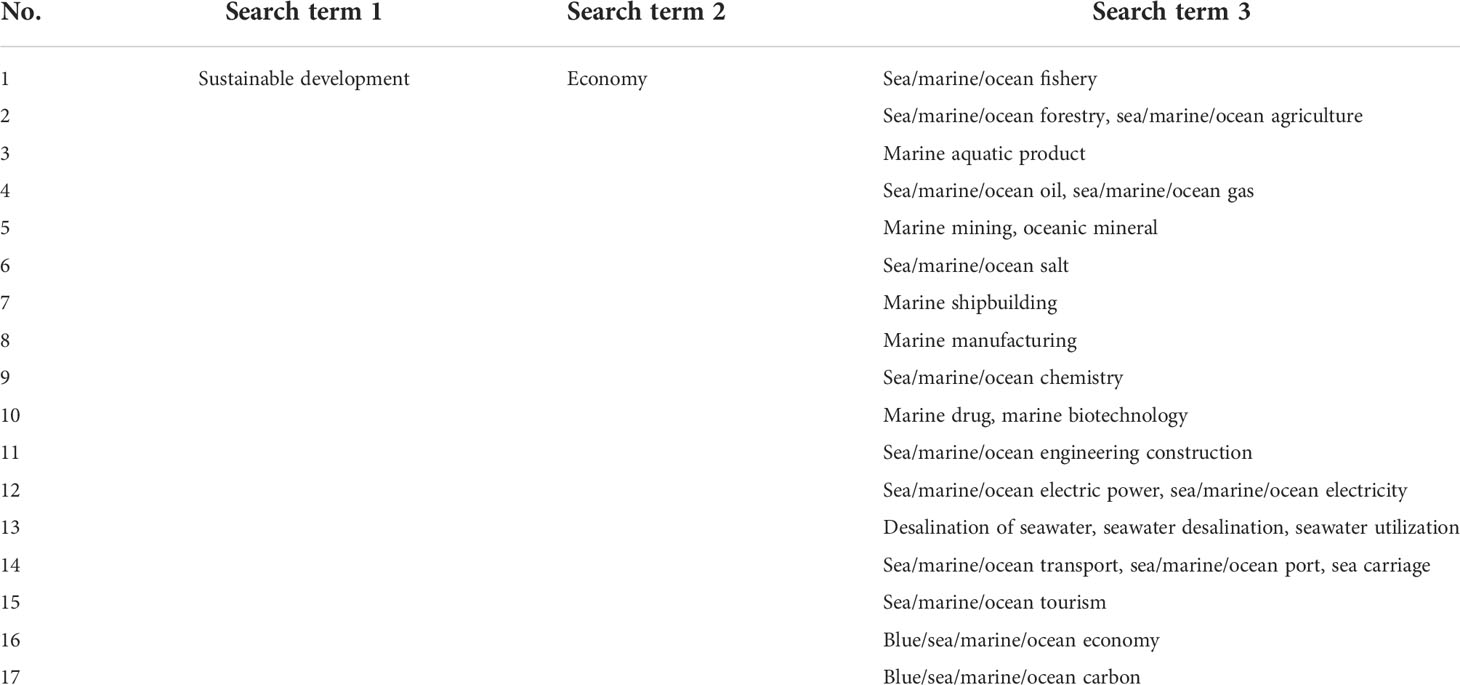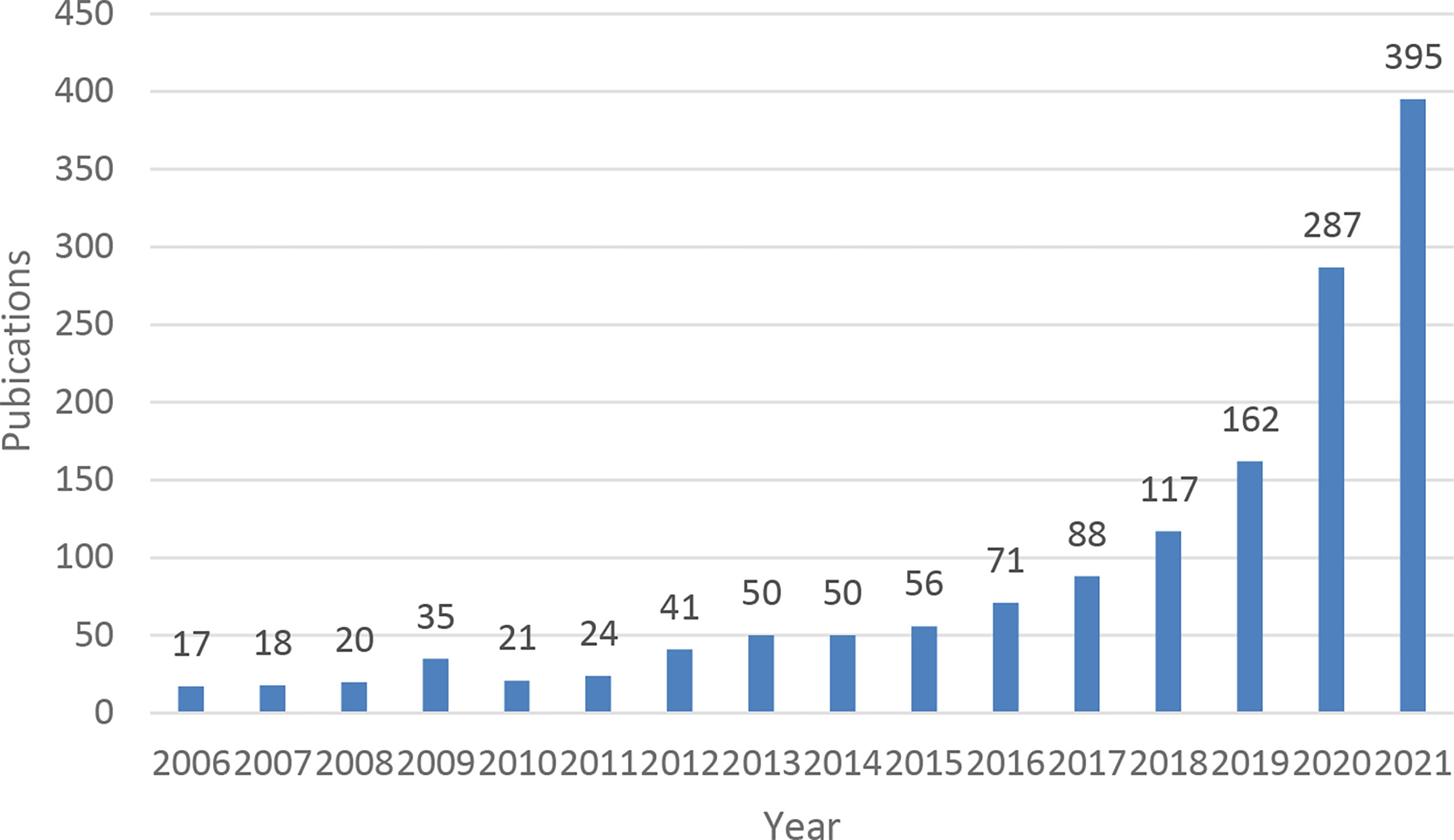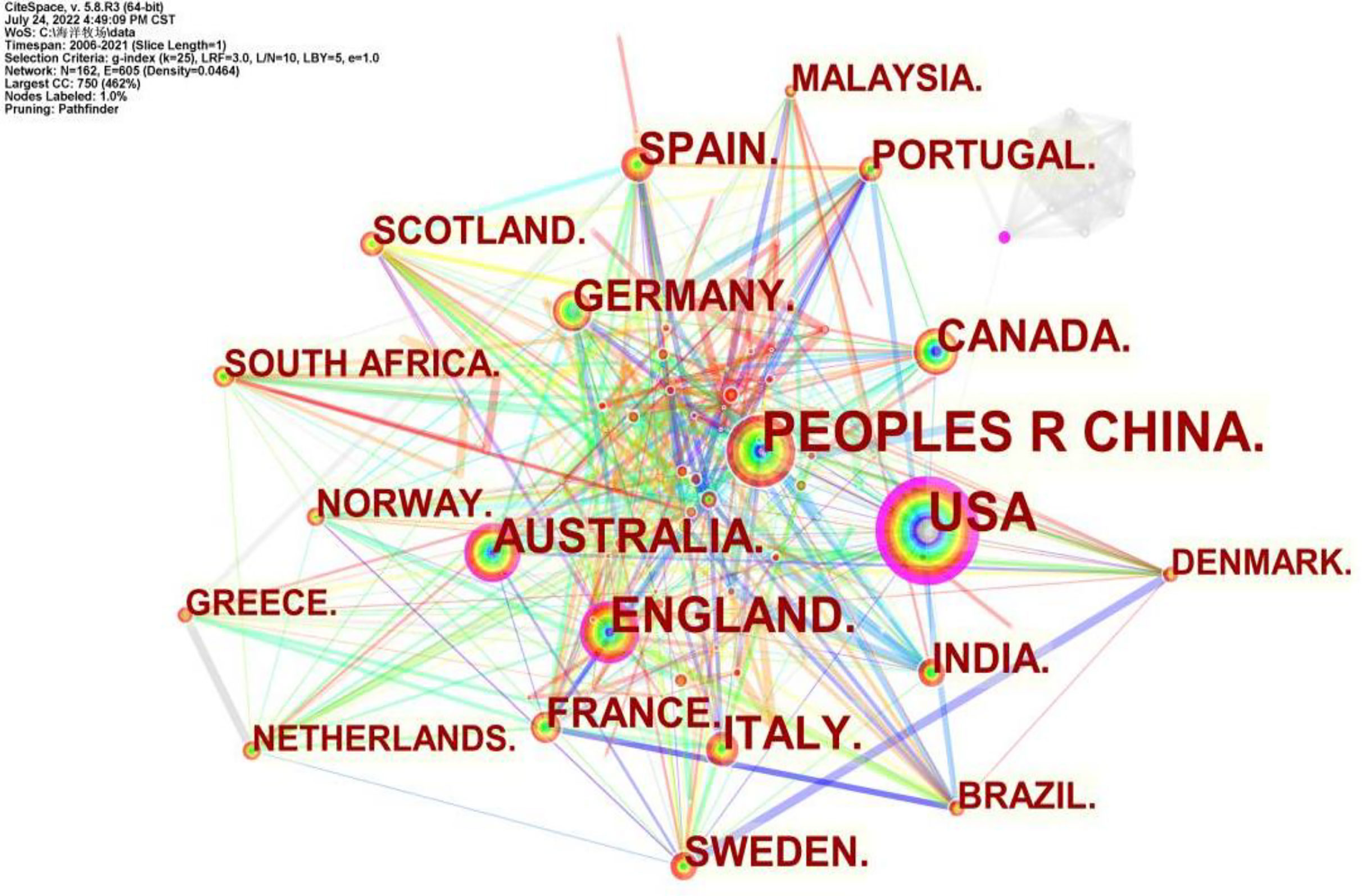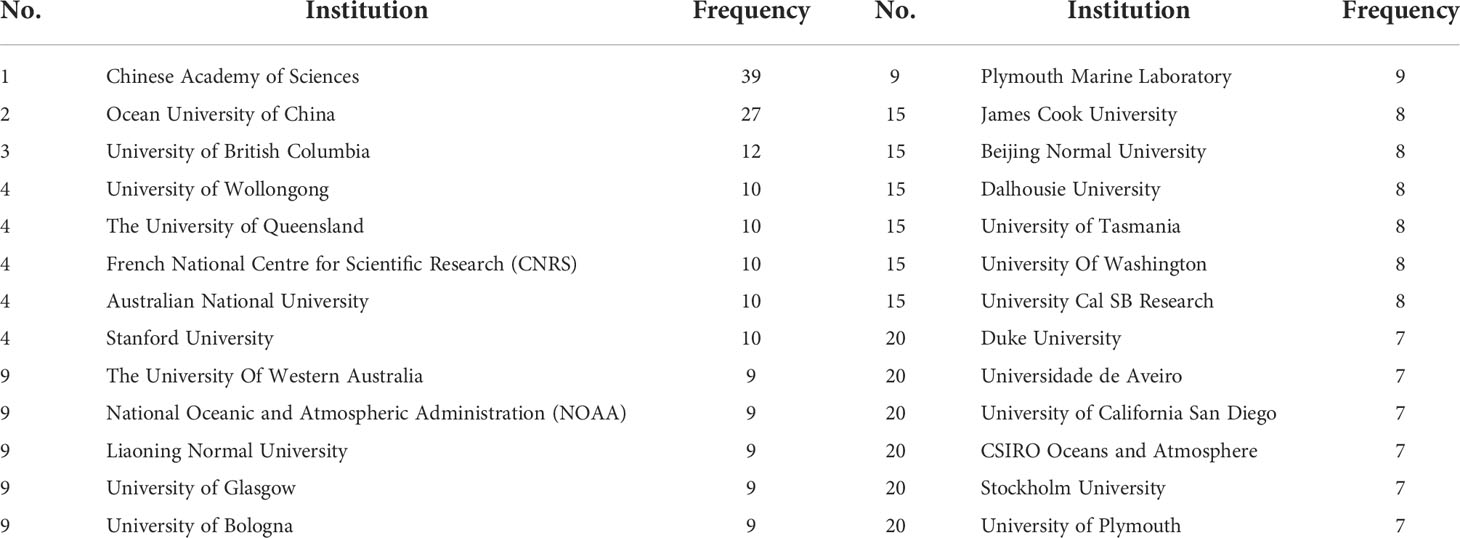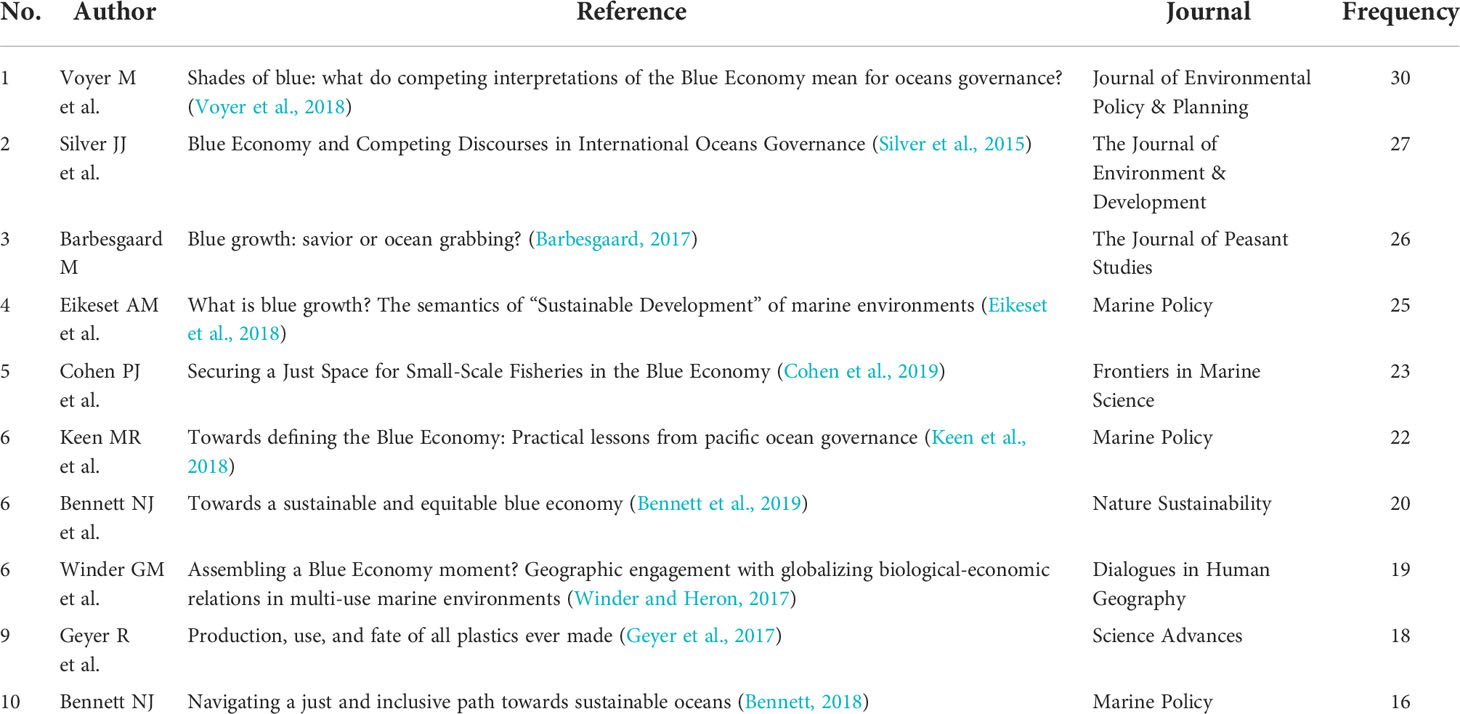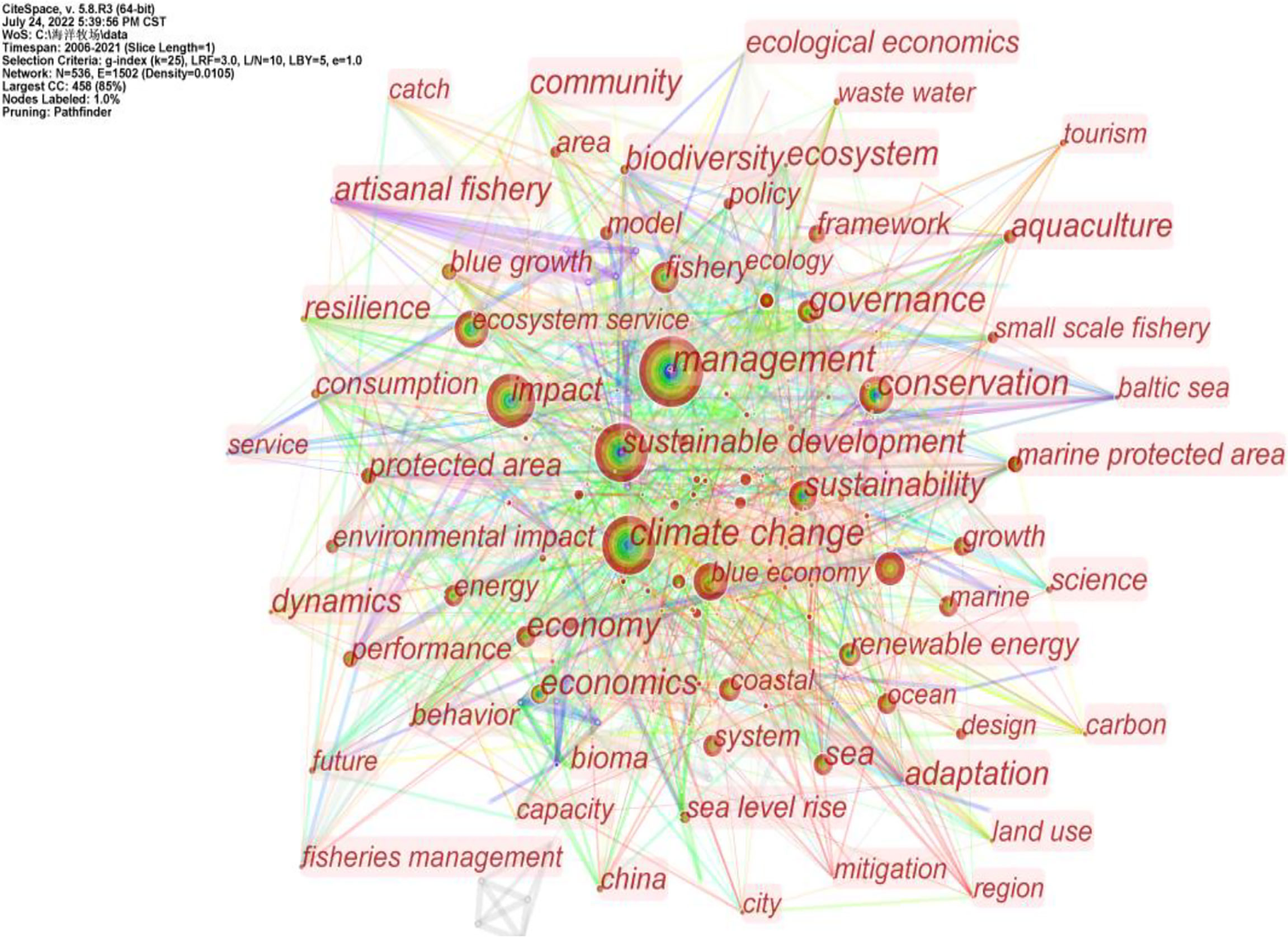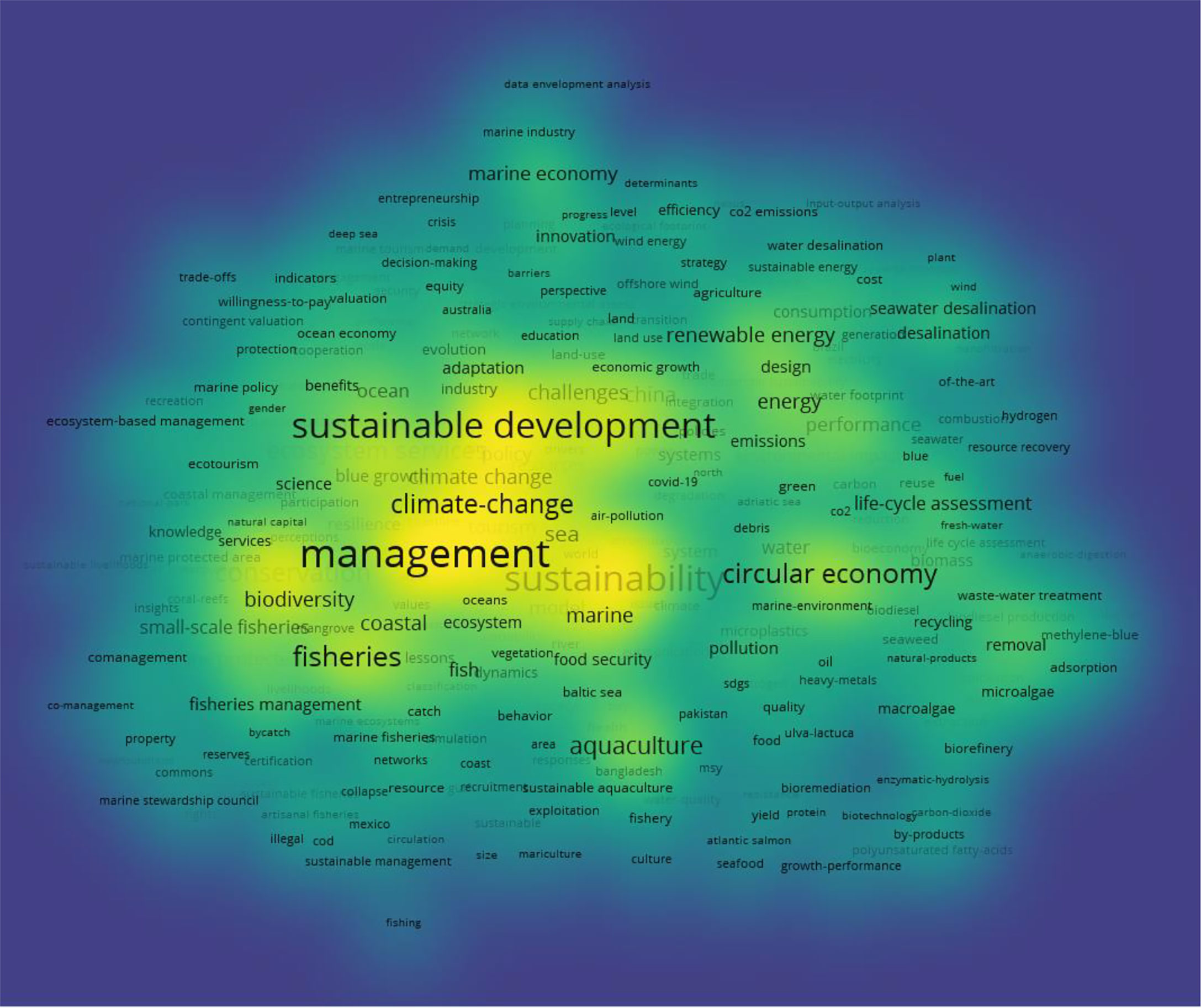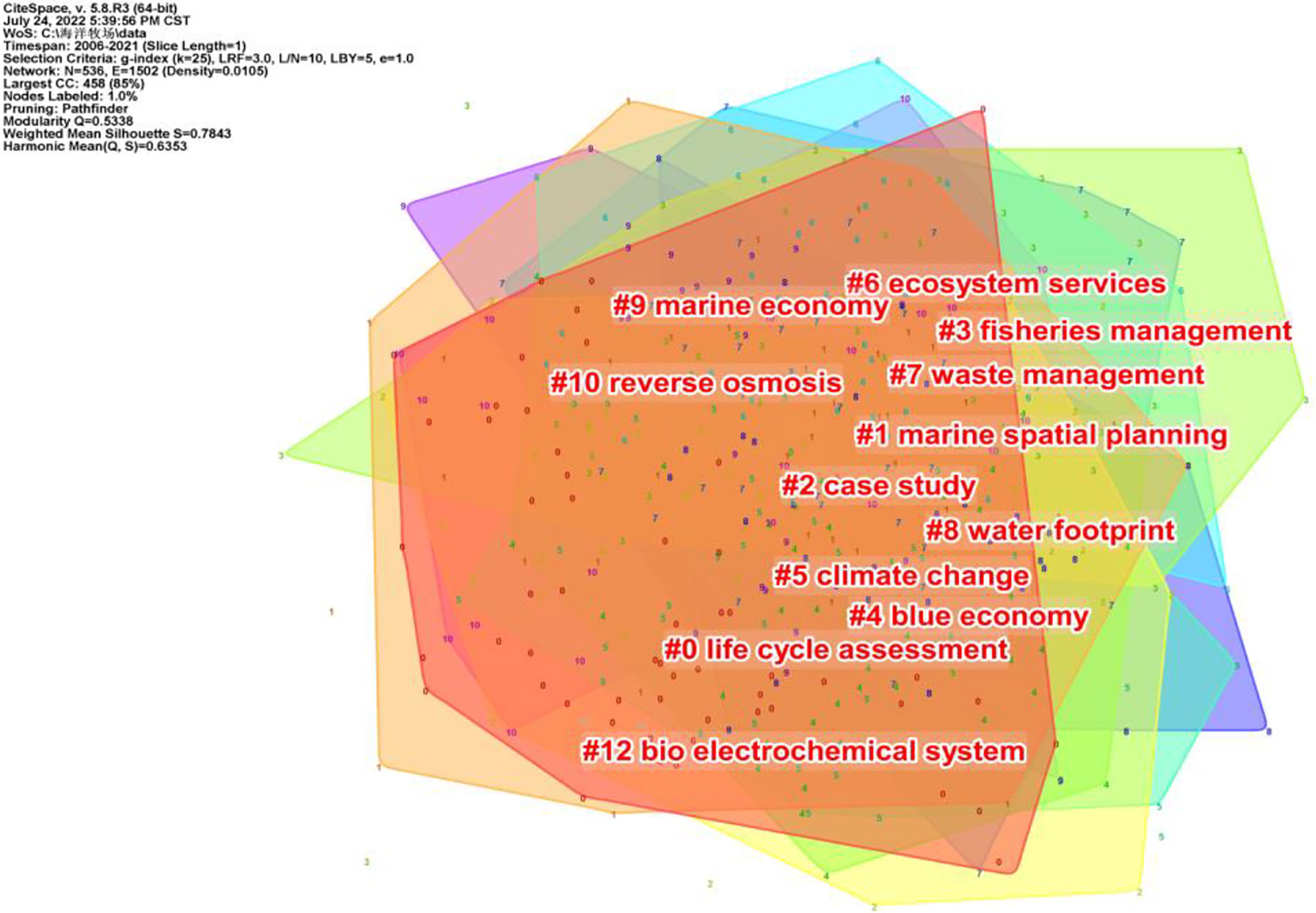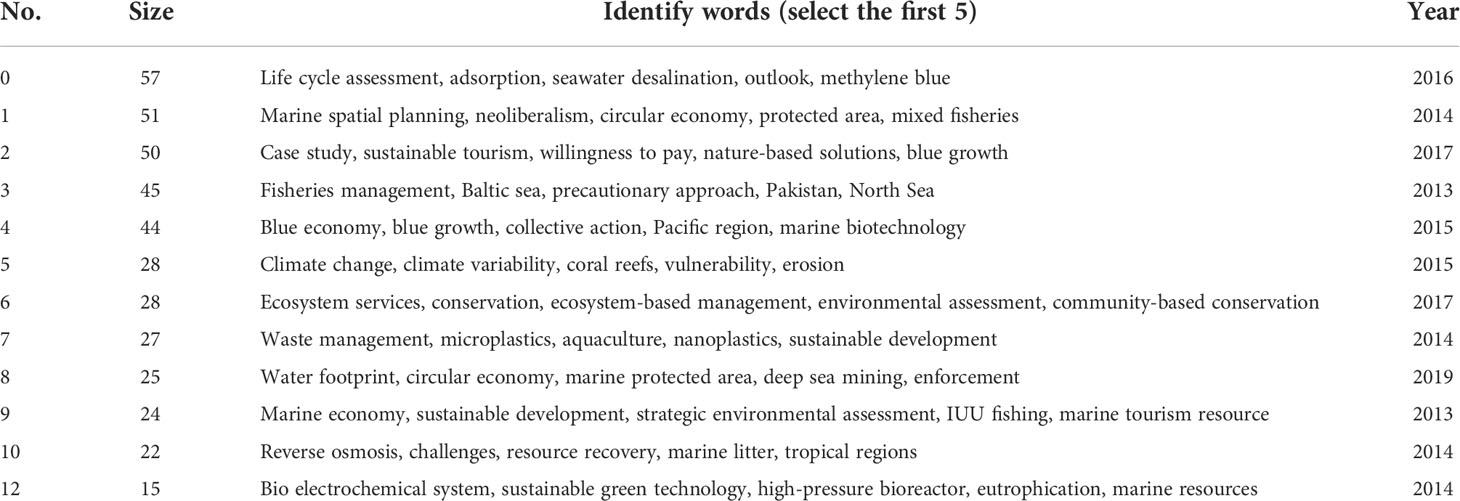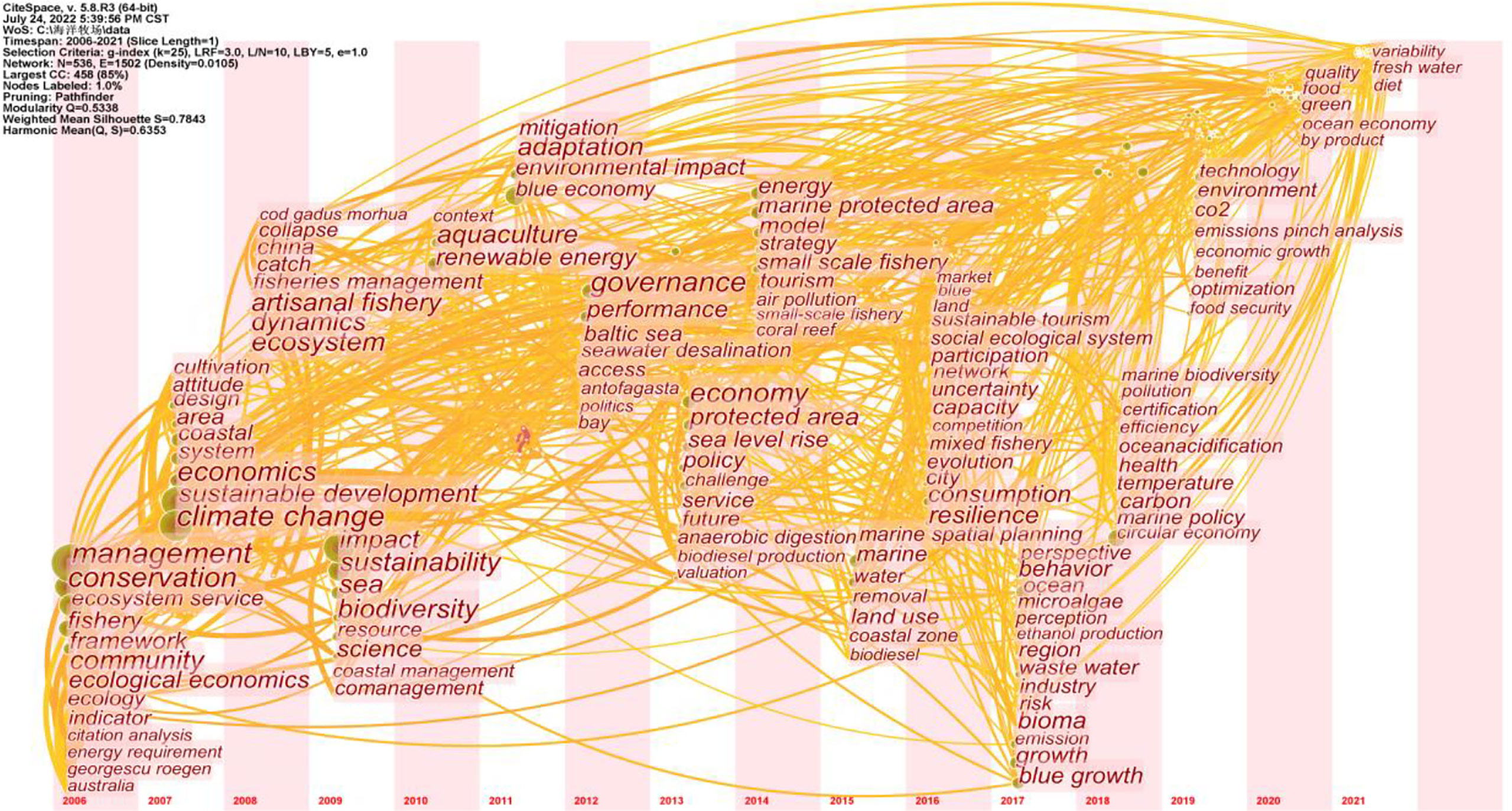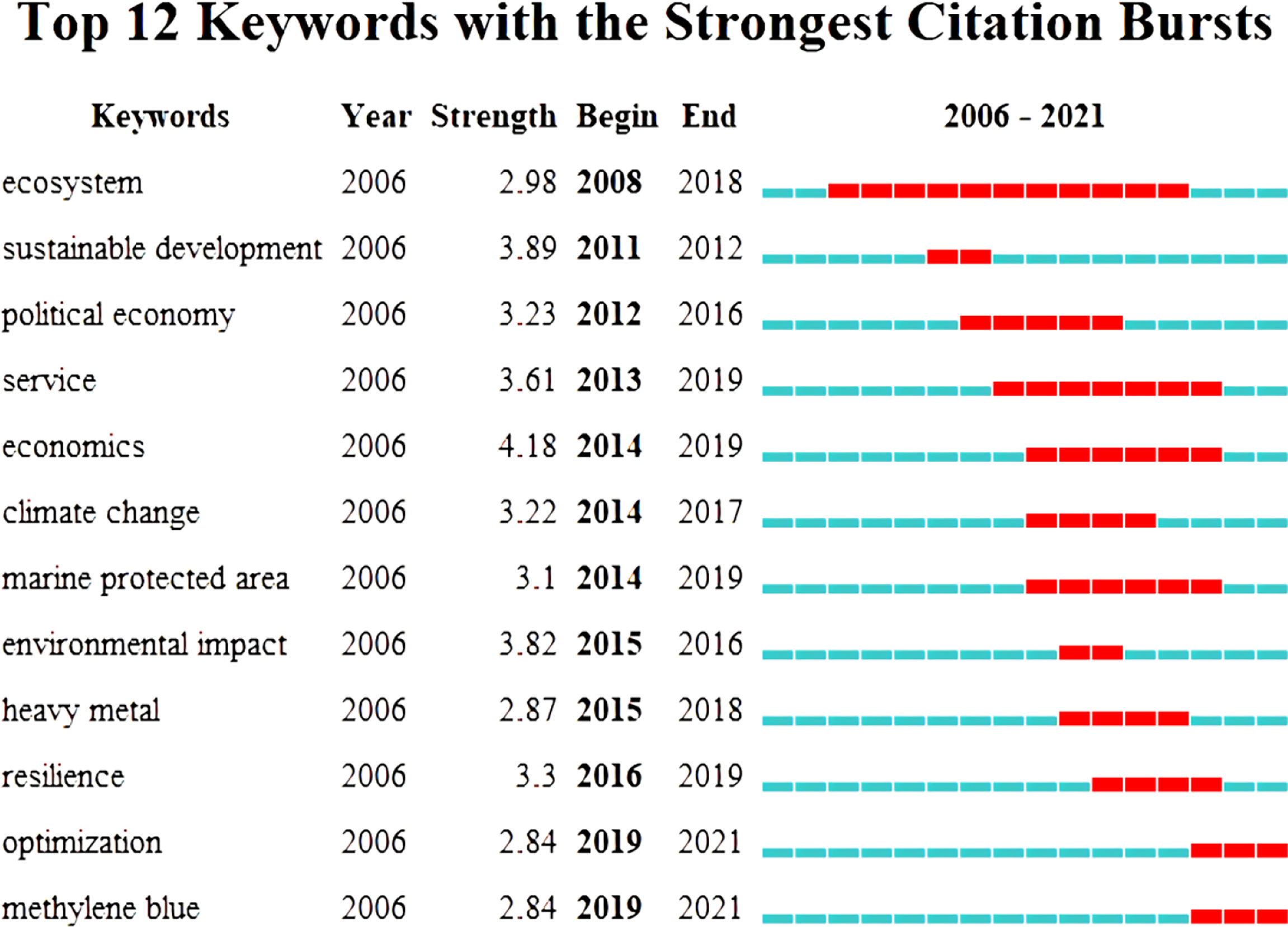- 1College of Marine Technology and Environment, Dalian Ocean University, Dalian, China
- 2East China Sea Fisheries Research Institute, Chinese Academy of Fishery Sciences, Shanghai, China
The blue economy is the sustainable use of ocean resources for economic growth, improved livelihoods, and jobs while preserving the health of the ocean ecosystem. In order to completely address the three dimensions of development, social, economic, and environmental in an integrated manner from 2015 to 2030, and to shift to a sustainable development path, the United Nations has formulated 17 global Sustainable Development Goals (SDGs), of which SDG14 is directly associated with the blue economy, which is also an essential material foundation for achieving other SDGs. In particular, the blue economy with the theme of sustainable and high-quality development of the marine economy will provide the possibility and important material guarantees for the eradication of poverty (SDG1), the eradication of hunger (SDG2), and the reduction of inequalities within and among countries (SDG10). In this study, CiteSpace and VOSviewer were used to visualize and analyze the global blue economy sustainability research field from 2006 to 2021, obtaining institutions, countries, cited authors, cited literature, journals, keywords, and clustered knowledge graphs. The results show that most of the blue economy sustainable development research is independent, with less cooperation among institutions. The research focuses on four research themes: fundamental theory and development direction, ecological and environmental sustainability, marine development methods, and comprehensive benefits and functions; the dynamics of the blue economy sustainable development research field is summarized.
Introduction
Marine and coastal economic activities have become major drivers supporting the global economy (McKinley, 2019). The scientific development of marine resources to achieve a sustainable marine economy has become the focus of world attention (Sarker et al., 2018). In order to comprehensively address the social, economic, and environmental dimensions of development in an integrated manner between 2015 and 2030 (United Nations, 2015) and shift to a sustainable development path (Sharif et al., 2019), the United Nations has developed 17 global Sustainable Development Goals (SDGs), of which SDG14 is directly associated with the ocean, which is also an important material basis for achieving other SDGs (Lee et al., 2020). In particular, the blue economy with the theme of sustainable and high-quality development of the marine economy will also provide the possibility and important material guarantees for the eradication of poverty (SDG1), the eradication of hunger (SDG2), and the reduction of inequalities within and among countries (SDG10) (Hernández-Delgado, 2015; Leslie et al., 2015). Therefore, it is crucial and urgent to promote the transformation of the marine development model, maintain the health of the marine ecological environment, and achieve high-quality and sustainable development of the blue economy (Weiand et al., 2021; Singh et al., 2021).
The concept of the blue economy was first proposed at the United Nations Conference on Sustainable Development in 2012 (Lee et al., 2020). Subsequently, the term “blue economy” appears frequently in national government reports and international conferences, but its exact meaning varies from country to country. The World Bank defined it as “the sustainable use of ocean resources for economic growth, improved livelihoods, and jobs while preserving the health of ocean ecosystem” (Lee et al., 2020). The blue economy is a socioeconomic phenomenon that emerged at a certain stage in the evolution of marine science and technology, marine economy, and marine culture. It is a regional economy with the theme of marine economy and the characteristics of the resources complementarity of marine and land, the industries correlation of marine and land, and the coordinated development of land and sea, and it aims to achieve Goal 14 of the 2030 Agenda for Sustainable Development, which is “to protect and sustainably use the oceans and marine resources for sustainable development” (United Nations Environment Programme, 2021).
The blue economy has an important supporting role for sustainable global economic development and has been recognized by human society (Choudhary et al., 2021). This area has also become a research hotspot (Surís-Regueiro et al., 2013). As the United Nations supports the implementation of SDG14 (United Nations, 2020), Estes et al. argued that monitoring marine biodiversity was an integral part of the sustainable growth of the blue economy (Jr. et al., 2021). An et al. pointed out that high-quality development of the blue economy is a realistic option for stimulating the vitality of regional economic growth and achieving the objective of establishing a powerful nation in the marine economy (An et al., 2022). Crona et al. proposed the integrated management of marine resources through collaboration in the marine sector to achieve sustainability and equity in the use of marine resources (Crona et al., 2021). Depellegrin et al. mentioned that the blue economy had the potential to promote the balanced socioeconomic development of the world’s oceans and coastal areas (Depellegrin et al., 2022). Cziesielski et al. proposed the development of blue natural capital to maintain the sustainable development of marine ecosystems (Cziesielski et al., 2021). Zhang and Wang noted that the development and utilization of marine resources had entered a new phase characterized by “refinement, orderliness, and high quality,” and it had become a top priority to coordinate the relationship among marine economy, ecology, and society (Zhang and Wang, 2022). The growth of blue capital value is closely related to the sustainable development of the ocean and is also a significant indicator of the efficient use of marine resources, ecological environmental protection, and coordinated socioeconomic development (Fondo and Ogutu, 2021). This research used the CiteSpace and VOSviewer scientific knowledge mapping software to visualize and analyze the literature pertaining to the sustainable development of the blue economy from 2006 to 2021. By investigating the global blue economy sustainable development research dynamics and research hotspots (Rey-Martí et al., 2016), the paper aims to gain insight into the research trends of blue economy sustainable development in order to provide references for future research.
Materials and methods
Source of data
The blue economy is a regional economy with the theme of marine economy and the characteristics of the resources complementarity of marine and land, the industries correlation of marine and land, and the coordinated development of land and sea. Consequently, the blue economy places a premium on the coordinated growth of marine-related industries. The “Industrial classification for marine industries and their related activities” (GB/T 20794-2021, 2021) classifies marine industries into 15 categories. In addition, marine blue carbon is an integral part of the sustainable development of the blue economy.
Therefore, based on the Web of Science database, this research selected the topic search of “theme” in the advanced search of WOS according to the research content related to the sustainable development of the blue economy. The search conditions were “Search term 1,” “Search term 2,” and “Search term 3.” The full-text data of “article” and “review” categories from 2006 to 2021 were selected, and a total of 1,452 valid sample documents were obtained (Table 1).
Research tools
CiteSpace 5.8.R3 (64-bit) and VOSviewer 1.6.16 were used as the research tools in this study. CiteSpace was developed by Dr. Chao-Mei Chen, a Chinese American, who wrote the visual analysis software based on the Java programming language (Chen, 2006). The software is widely used for data mining and information visualization and can be used to represent collaborations, hotspot analysis, and evolutionary trends in a research field by drawing information visualization maps (Chen et al., 2012). VOSviewer is a graphical analysis tool developed by Ludo Waltman and Nees Jan van Eck at Leiden University in the Netherlands for analyzing literature using visualization approaches (Eck and Waltman, 2010). The function of this software is the visual analysis of the literature, which analyzes a large volume of sample data with superior graphical analysis and presentation capabilities (Sandeep-Kumar et al., 2021). CiteSpace and VOSviewer, as visualization software for mapping scientific knowledge, have been utilized extensively in scientific research worldwide (Wang and Lv, 2021; Zhu et al., 2021).
Results and analysis
Descriptive analysis
The sample for this study consisted of 1,452 papers published by 466 authors from 422 institutions in 162 countries and 309 subject categories (Table 2).
Published volume changes and topic category analysis
Figure 1 illustrates the annual number of publications on the Web of Science for research literature related to the sustainable development of the blue economy. There was an upward trend in the number of articles published from 2006 to 2021. The study period can be divided into the following three phases: phase I, covering the years 2006–2011; phase II, covering the years 2012–2016; and phase III, covering the years 2017–present. The number of publications in the first phase of the study in question fluctuated between 2006 and 2011, with a low of 17 articles in 2006 and a high of 35 articles in 2009, indicating a start-up phase; from 2012 to 2016, publication output increased and the number of articles nearly doubled that of the previous phase, indicating that it was the beginning phase. The total number of publications in the third phase (1,049) is significantly higher than in the previous two phases (135 and 268 in the first and second phases, respectively), which was the accelerated phase. These findings indicate that sustainable development of the blue economy is receiving more and more attention from scholars and that there are an increasing number of study findings on the subject.
In order to further analyze the research themes involved in the field of blue economy sustainability research over the last 15 years, the top 10 research themes have been analyzed as shown in Table 3. The results show that the top 2 research themes were “Environmental Sciences & Ecology” and “Environmental Sciences,” with frequencies of 683 and 288, respectively, and the last two research themes were “Geology” and “Oceanography,” with a frequency of 100 times. It can be demonstrated that environmental science has become the leading direction in this field of research, providing the basis for its development. Thus, environmental disciplines form the basis of research on the sustainable development of the blue economy.
Three of the top 10 research themes are related to environmental science, namely, “Environmental Sciences & Ecology,” “Environmental Sciences,” and “Environmental Studies,” which serve as the foundation for research on the sustainable development of the blue economy. Other research themes in this field include “Sciences & Technology - Other Topics,” “Green & Sustainable Science & Technology,” “Engineering,” “Environmental Studies,” “Water Resources,” “Marine & Freshwater Biology,” “Geology,” and “Oceanography.” It illustrates the close relationship between the sustainable development of the blue economy and water resources protection, geographic science, oceanography, and green sustainable technology, as well as the fact that the field has strengthened its cross-integration with disciplines such as environmental science, ecology, geology, engineering, water resources, marine and freshwater biology, and oceanography due to the advancement of science and technology over the past 15 years. This demonstrates that multidisciplinary support is necessary for the sustainable development of the blue economy. Moreover, the field’s extensive research has indirectly contributed to the development of other disciplines.
Country and institutional analysis
As of 2021, the search results of the Web of Science database showed that 162 countries had published literature related to the sustainable development of the blue economy in the past 15 years, among which China had published the most literature with 250 articles, accounting for 17.2%, followed by the United States with 228 articles, accounting for 15.7%; the other two prominent nodes were the United Kingdom and Australia with 137 articles and 118 articles. The top 10 countries in terms of the number of publications were mostly Europe and the United States (Table 4).
By selecting Node types as Author, time range as 2006–2021, and Years Per Slice as 1 year, the CiteSpace was run to get the co-occurrence knowledge map of blue economy sustainable development research countries (Figure 2). Each node in the graph represents a country/region, the size of the node indicates the number of articles issued, and the number and thickness of the connecting lines show the cooperation relationship and closeness between countries/regions. From Figure 2, we can see that the number of connecting lines is 605, the number of nodes is 162, and the density of the cooperation network is 0.0464, thus indicating that the countries/regions in the field of sustainable development of blue economy cooperate less with each other.
As shown by the frequency of publications related to the sustainable development of the blue economy from 2006 to 2021 (Table 5), the top 3 institutions in terms of the number of publications were the Chinese Academy of Sciences, Ocean University of China, and University of British Columbia, with 39, 27, and 12 publications, respectively. Among the institutions with publication frequency ≥7, seven were from Australia (e.g., University of Wollongong), four were from China (e.g., Chinese Academy of Sciences), four were from the USA (e.g., Stanford University), four were from the UK (University of Glasgow, etc.), and the rest were from France (CNRS), Italy (University of Bologna), Canada (Dalhousie University), Portugal (University of Aveiro), and Sweden (Stockholm University). The top 2 institutions in terms of the number of publications were from China.
Cited author analysis
The number of citations an author receives in a relevant field is a direct reflection of his popularity in the field and his historical position in the field. The highly cited author often plays a foundational and pioneering role in his or her field of study or has achieved groundbreaking research in the development of the field.
As shown in Table 6, the author with the highest frequency of citations in the field of sustainable development of the blue economy is Costanza R, with a centrality of 0.12 and 76 citations, with an increasing trend of citations. Moreover, his study focused more on ecological economics and ecosystem services, and the study would contribute to achieving a balance between ecosystems and human wellbeing (Hernández-Blanco et al., 2022). As an accomplished scientist in the field of ecosystem sustainability research, Costanza R proposed that ecosystem services contribute substantially to the welfare economy, contribute to the health and sustainability of the ecological economy, and had been widely used in the field of marine blue economy sustainability research (Costanza et al., 2017).
The second-ranked author is Pauly D with a centrality of 0.11 and 66 citations. He specialized in watershed ecosystems and fisheries management research, with an emphasis on the analysis of the economic benefits of fisheries and ecological benefits of waters associated with fisheries management, and the study would contribute to the sustainable use of fisheries resources (Pauly and Zeller, 2017). Other scholars with outstanding contributions, such as Bennett NJ, had proposed the theory that formulating and implementing systematic management strategies could facilitate the establishment of an equitable and sustainable blue economic order by means of inclusive management (Bennett et al., 2019). This research has been cited 59 times. He was interested in providing a methodology for developing policies for sustainable oceans, bridging the gaps in the existing system. Halpern BS focused on marine ecology, marine biology conservation, and other directions (Halpern et al., 2013), and the research has been cited 59 times. In conclusion, the abovementioned scholars have jointly promoted the research process of sustainable development of the blue economy and expanded the research content in this field, and the research methods serve as an important point of reference for future scholars.
Cited journal analysis
The co-citation analysis of highly cited journals is useful for quickly locating academic journals with high recognition in related fields, thereby aiding scholars to quickly grasp the research hotspots in the field. The higher citation frequency, the higher authority of the academic journal in the field , and the higher the academic recognition of the journal. Therefore, high-quality academic journals contribute significantly to the advancement of the discipline. As shown in Table 7, from 2006 to 2021, the highest ranked journal among the cited journals was Marine Policy; the top 10 academic journals all had more than 240 citations in the field of blue economy sustainability; the lowest cited among the top 10 academic journals is Sustainability with 242 citations. It also included the world’s top academic journals, such as Science and Nature, with 441 and 348 cited occurrences. It shows that the above academic journals occupy an important position in the field of blue economy sustainable development research. Scholars can focus on the high-quality academic findings published in these journals, gain insight into the analysis of research hotspots, and investigate the development dynamics.
Cited reference analysis
Co-citation can be defined as the frequency with which two papers are simultaneously cited by other papers and can be used to measure the similarity of the literature. In this paper, we analyze the literature co-citation to analyze the basic knowledge structure in the field of blue economy sustainable development research. Literature co-citation can be used to obtain the highly cited papers with authority.
The top 10 most cited papers are listed in Table 8. Michelle Voyer, Jennifer J. Silver, Nathan J. Bennett, and Gordon M Winder authored the four most-cited papers with 18, 15, 13, and 13 citations, respectively. Michelle Voyer discussed the areas of consensus and conflict in the development of marine industries within the blue economy (Voyer et al., 2018). Jennifer J. Silver analyzed the role of the blue economy in a discourse power of global environmental governance (Silver et al., 2015). Mads Barbesgaard studied the fundamental issues of control and access to blue economy resources in ocean development and proposed a “win–win” solution to address climate change issues and ensure blue growth (Barbesgaard, 2017). Eikeset AM explained and deepened the concept of blue growth based on previous findings to aid future generations in comprehending blue growth (Eikeset et al., 2018).
Keywords analysis
Keywords for the sustainable development of the blue economy
Keywords are a high-level summary of the main content and research topic of the paper. The frequency of a keyword reflects the number of publications related to the keyword. The higher the keyword frequency, the more relevant the research results, which also reflects the research hotspots in the field.
By selecting Node types as keyword and setting other parameters as the author co-occurrence knowledge graph parameters, CiteSpace was run to generate the keyword co-occurrence knowledge graph (Figure 3) and the list of keyword frequencies and their centrality (Table 9). The size of the node corresponding to one keyword represents the frequency of the keyword. The larger the node, the higher the frequency and attention of the keyword. The co-word clustering analysis was performed by VOSviewer, and “Label View” was used to display the co-word clustering (Figure 4). The keywords are a high-level summary of the content of the paper, so the larger nodes in Figure 3 and the larger yellow areas in Figure 4 represent research hotspots in the field of sustainable development of the blue economy.
The research on the sustainable development of the blue economy mainly involves marine economy, climate change, sustainable management, and fisheries. Among these, the larger nodes are management, sustainable development, climate change, blue economy, impact, ecosystem service, etc., indicating that these keywords appear more frequently. As shown in Table 8, the centrality of the keywords such as management, sustainability, impact, conservation, and fishery is higher, indicating that these directions have received higher attention in the field of sustainable development of the blue economy.
Keyword clustering of sustainable development of the blue economy
Based on the keyword co-occurrence knowledge map (Figure 4), CiteSpace was run to obtain the keyword clustering knowledge map (Figure 5) and the keyword co-occurrence network clustering table (Table 10). The clusters in Figure 5 can reflect the current status of hot issues in the field of sustainable development of the blue economy, including “life cycle assessment,” “marine spatial planning,” “case study,” “fisheries management,” “blue economy,” “climate change,” “ecosystem services,” “waste management,” “water footprint,” “marine economy,” “reverse osmosis,” and “bio electrochemical system” (12 cluster labels).
Based on the analysis of the co-occurrence of keyword clusters in Figure 5 and Table 10, the research contents of the clusters are intersecting with each other. The research on the sustainable development of the blue economy can be categorized into four themes—”basic theory and development direction,” “ecological and environmental sustainability,” “marine development methods,” and “comprehensive benefits and functions”—which are further discussed below.
1) Basic theory and development direction research: The statistics show that some scholars place a greater emphasis on the theoretical research on the sustainable development of the blue economy, as well as the exploration and forecasting of the development path of this field. N. J. Bennett summarized the concept of “political ecology of the ocean and coastal environment” by reviewing the theory of sustainable development of the blue economy (Bennett, 2019); Robert Costanza et al. developed a systematic dynamic prediction model related to the UN SDGs and the Sustainable Health Index (SWI) through a detailed list of the UN SDGs (Costanza et al., 2016); Jean-Baptiste Jouffray et al. addressed the dilemma of rapidly increasing human demand for ocean resources and proposed responses and recommendations for The Blue Acceleration-Sustainable use and fair competition for ocean food, matter, and space (Jouffray, 2020); Poonam Choudhary et al. proposed a more scientific and systematic optimization and upgrading of blue industry sectors including shipping, fisheries, and tourism for sustainable development of the blue economy (Choudhary et al., 2021); Camilla Novaglio et al. envisioned the technical feasibility of a future offshore blue economy and identified measures to achieve a more sustainable and equitable offshore blue economy (Novaglio et al., 2022); M. Andrés pointed out that the marine sector must design and implement inclusive and equitable policy measures in order to achieve sustainable development of the blue economy and the benefits it brought (Cisneros-Montemayor et al., 2019). According to the relevant studies, a more complete basic theoretical system and a clear development direction have been established in the field of blue economy sustainable development research.
2) Research on marine ecological and environmental protection: Statistically, researchers in the field of blue economy sustainability focus on keywords such as “waste management,” “circular economy,” “climate change,” and “seawater desalination.” For example, M. Hong and E. Y. X. Chen proposed the development of recyclable chemical polymers as a more sustainable solution to the potential unpredictable environmental problems associated with the degradation of synthetic polymers in the ocean (Hong and Chen, 2017). By analyzing the case of chitin extraction from shellfish waste, Roberto Nisticò pointed out that the reuse of aquatic biological waste is one of the effective measures to cope with sustainable development (Nisticò, 2017); Cao et al. proposed the establishment of a sustainable aquaculture industry with scientific planning of the use of aquaculture waste so that aquaculture stocking density and pollution load are below environmental capacity, by analyzing the negative impact of aquaculture waste on the environment and the traditional methods of aquaculture waste treatment (Cao et al., 2007); Argyris Panagopoulos proposed two zero liquid discharge (ZLD) systems to effectively address the potential environmental threat of brine discharge from desalination plants (Panagopoulos, 2021); Á. F. Gambín and E. Angelats pointed out that the assessment of water quality is key to the protection of marine ecosystems and reviewed and classified the existing methods and techniques for water quality monitoring (Gambín et al., 2021); S. Merlo and X. G. Durany discussed the progress of research and application of microalgae as a biofuel and analyzed the potential of marine microalgae as an alternative to fossil fuels with the aim of reducing greenhouse gas emissions (Merlo et al., 2021). From relevant studies, it can be concluded that marine ecological and environmental protection is an important part of the sustainable development of the blue economy.
3) Research on marine development methods: Statistically, researchers working on this topic have focused on the keywords “ecosystem services,” “marine economy,” “marine resources,” and “sustainable development” in order to establish a sustainable and equitable approach to ocean development. In the course of their research, H. Y. Tian, D. B. Lindenmayer, and G. T. W. Wong developed a methodological framework for assessing the level of coastal development and natural resource exploitation in response to the difficulty of striking a balance between economic growth and environmental protection when developing and managing coastal waters (Tian et al., 2018); Huanhuan Rao et al. established the marine ecological damage compensation (MEDC) criteria related to ecosystem services by analyzing the case of MEDC in Xiamen (Rao et al., 2014); K. Hassanali investigated ways to achieve socioeconomic development of islands and the sustainable use of coral reef biological resources based on coral reef ecosystems using the case of the Buku Reef Marine Park in Tobago, West Indies (Hassanali, 2013); Paula Satizábal et al. systematically analyzed the strategies and results of resource management for development in the Philippines, concluding that marine development must take into account social justice and environmental sustainability (Satizábal et al., 2020); W. H. Ren et al. proposed the sustainable development of China’s blue economy with the starting point of clean production in China’s oceans (Ren et al., 2018); S. Sarker et al. assessed the blue economy potential of Bangladesh and developed a regulatory framework with a view to promoting sustainable growth of the blue economy in Bangladesh (Sarker et al., 2018). In summary, research in this area focuses on analyzing methods for achieving sustainable development of the blue economy using specific case studies.
4) Comprehensive benefits and functional studies: Marine environmental protection, sustainable development of marine resources, and coordinated socioeconomic development are important features of the sustainable development of the blue economy. In the study, scholars mostly used keywords such as “marine tourism resources,” “blue growth,” “fisheries management,” and “protected area.” Scholars such as A. Phelan and Y. Okan proposed ecotourism as a way to develop the marine economy through the use of marine natural and cultural resources, which effectively resolves the incompatibility of resources, environment, and socioeconomic development in the process of marine development and utilization (Yilmaz et al., 2013; Phelan, 2020); K. Hassanali argued that the development of the marine park industry must be accompanied by consideration of ecological conservation in order to facilitate the movement of marine parks into sustainable tourism (Cisneros-Montemayor et al., 2020). C. Hoerterer et al. pointed out the functional role of shark resources in the ecotourism industry, thereby promoting the social, economic, and ecological sustainability of the industry (Hoerterer et al., 2020); Ramiro Arcos-Aguilar et al. systematically analyzed the economic value of the diving industry in Mexico and suggested the development of a diving industry in marine protected areas where fishing is prohibited to promote the sustainable use of the oceans (Arcos-Aguilar et al., 2021); C. M. Hall recommended that recreational fisheries be publicized and promoted to exploit their economic potential as well as their potential to cope with climate and environmental change (Hall, 2021); T. Tong proposed recommendations and countermeasures for the marine cultural industry with a view to promoting sustainable development of the marine economy (Tong, 2020). In summary, on the basis of conserving the ecological environment, new driving force for marine economic development must be cultivated, adding “leisure,” “tourism,” and “vacation” as new attributes. It can extend the marine industry chain, improve the added value of the marine economy, and favorably promote the high-quality development of the marine economy.
Analysis of research trends
Based on the change of keywords over time, we can understand the dynamics of the blue economy sustainable development research frontier and import the literature data into CiteSpace to generate the knowledge map of the blue economy sustainable development research frontier (Figure 6). The nodes shown in the graph are all the newly appearing keywords during the specified time period. The font size of the keywords represents the frequency of the keywords, and the keywords appearing before and after the keywords in the same article will be linked by the connecting lines to generate the graph.
As can be seen from Figure 6, from 2006 to 2009, the new high-frequency keywords were sustainable ability, management, conservation, sustainable development, climate change, etc., indicating that the sustainable development of the blue economy at this stage has attracted the attention of scholars worldwide. From 2009 to 2014, the new keywords with high frequency included impact, fishery, aquaculture, renewable energy, environmental impact, consumption, biodiversity, protected area, tourism, etc., indicating that the impact of marine industry development on marine ecosystems (e.g., marine ecosystem, biodiversity) and the solutions to these problems are hotspots for global scholars’ research during this period. From 2015 to 2021, the new keywords with high frequency were resilience, waste water, blue growth, marine policy, carbon, CO2, variability, etc., indicating that the sustainable development model of the blue economy (circular economy, etc.) and its solutions (carbon neutrality, government management, etc.) have become the focus of global scholars in recent years.
Keywords with the strongest citation bursts are those that appear multiple times or are used with high frequency in a short period of time, and the change in burst frequency reflects the evolutionary trend of research hotspots in the field. As can be seen from Figure 7, the emergent term was “ecosystem” from 2008 to 2018. For instance, Glenn-Marie Lange and others discussed research on marine biological resource conservation and sustainable economic development, highlighting the marine economy’s reliance on ecosystems (Lange and Jiddawi, 2009). The emergent term for the period 2011–2012 was “sustainable development,” such as W. M. Kaczynski who proposed that human society should develop the ocean in a sustainable manner (Kaczynski, 2011). The term “political economy” emerged during 2012–2016, such as Paul Foley et al. who analyzed the new politics of transnational sustainability governance in the fisheries sector and the political economy of Marine Stewardship Council certification using the case of the offshore shrimp industry in Newfoundland and Labrador (Foley, 2012; Foley and Havice, 2016). The emergent term for 2013–2019 was “service”; for example, Marco Custódio argued the application of ecosystem services to the aquaculture industry for sustainable development (Custódio et al., 2019), and Helen Ross proposed the maintenance of marine ecosystem services in Asia-Pacific and Oceania, which required community and government collaboration (HelenRoss et al., 2019). The emergent terms were “economics” and “marine protected area” during 2014–2019, such as Andrew Rylance who investigated the economic value of tourism contributions to marine protected areas in Mozambique (Rylance, 2016) and Niels Jobstvogt who assessed the value of ecosystem cultural services at marine sites in the UK (Jobstvogt et al., 2014). The emergent term for 2014–2017 was “climate change,” such as E.A. Hernández-Delgado who pointed out that climate change has become a new threat to tropical coastal ecosystem services (Hernández-Delgado, 2015). The emergent term for the period 2015–2016 was “environmental impact”; e.g., Wu Chin-Cheng analyzed the vulnerability of the southwest coast of Taiwan to climate change impacts (Wu, 2016). Scholars such as R. J. H. Herbert addressed the issue of the potential environmental impacts of oyster farming and formulated guidelines to meet the multiple interests of the parties involved with a view to promoting sustainable development (Herbert et al., 2016). The emergent term for the period 2015–2018 was “heavy metal”; e.g., Kayil Veedu Ajayan et al. studied the ecological remediation potential of microalgae to reduce the pollution load of heavy metals in the environment (Ajayan et al., 2015). Francesco Todaro et al. evaluated the effectiveness of two solutions as remediation options for marine sediments subjected to heavy metals, etc. (Todaro et al., 2018). The emergent word for the period 2016–2019 was “resilience,” such as Shaikh Mohammad Kais et al. who studied climate vulnerability and resilience in Bangladesh for the case of shrimp aquaculture in the region (Kais and SaidulIslam, 2018). Jasper Hessel Heslinga et al. studied the potential contribution of tourism to building socioecological resilience in the Wadden region of the Netherlands (Heslinga et al., 2016). The emergence rate of “optimization” and “methylene blue” has continued until now, which can indicate that the two keywords are the current research hotspots in the field of sustainable development of the blue economy; for example, Chinglong Shao et al. discussed the optimization of China’s marine industry and its linkage with marine economic growth and technological innovation (Shao et al., 2021) and Mukherjee et al. proposed purification solutions for the degradation of methylene blue solution in sewage and recycling of sewage after treatment with the aim of reducing pollution emissions (Mukherjee et al., 2021).
Conclusion and outlook
With the deepening of human development of the ocean, research on the sustainable development of the blue economy has attracted great attention from human society. In order to understand the research progress in the direction of sustainable development of the blue economy, this paper uses bibliometric software to organize and analyze the literature in this field, and the conclusions are as follows.
First, in terms of the number of publications, the research literature in the field of blue economy sustainable development is increasing annually, and the research on blue economy sustainable development is becoming more and more popular.
Second, from the theme of the publication, the field of sustainable development of the blue economy is mainly based on environmental science, and the disciplines involved include geology, engineering, water resources, marine and freshwater biology, oceanography, etc., indicating that sustainable development of the blue economy is a system engineering and requires multidisciplinary scientific and technological support, while the research in this field also promotes the development of related disciplinary fields.
Third, from the perspective of high-producing institutions, there is a significant disparity in the volume of publications between institutions, and the majority of institutions conduct research independently, with little collaboration with other institutions. This is mainly because each research institution focuses solely on the professional field in which it excels, with a high degree of specialization in research issues, but lacks research on global and systematic issues. The development of the blue economy involves marine aquaculture, marine ship engineering and transportation, marine energy exploitation, marine tourism, sea salt industry, etc., which requires multidisciplinary cross-fertilization; consequently, we must encourage the cooperation of research institutions in the future to promote the development of the marine circular economy.
Fourth, in terms of research fields and the amount of publications among countries, relevant research in the field of blue economy sustainable development is mainly published in journals in the fields of ocean, environment, and sustainable development. There are more relevant scientific research results from China, the United States, the United Kingdom, Australia, and other European coastal countries, indicating that the abovementioned countries have placed a premium on the research on the sustainable development of the blue economy since 2006.
Fifth, from the development trend of research hotspots, the research on the blue economy has shifted from attracting global attention to the research on the impact of the development of ocean-related industries on marine ecosystems, to the current research on sustainable development models (circular economy, etc.) and solutions (carbon neutrality, government management, etc.) of the blue economy, indicating that achieving the goal of sustainable development of the blue economy is the current global consensus.
This study provides a preliminary analysis of the development dynamics in the field of blue economy sustainable development and also provides reference materials for future research. However, since the sample data of this study are only from the Web of Science core database, there is a risk of insufficient literature inclusion, and in future studies, we will consider combining relevant literature from other databases for analysis, so as to better comprehend the development trend of blue economy sustainable development research.
Data availability statement
The raw data supporting the conclusions of this article will be made available by the authors, without undue reservation.
Author contributions
JSL: data collection and processing and thesis writing. ZY: article writing guide and project sponsor. YL, JXL, MY, LN, and MX: revision of the article. All authors contributed to the article and approved the submitted version.
Funding
This research was funded by Ministry of Science, P.R. China (grant number: 2019YFD0901302) and Dalian Science and Technology Council (grant number: 2021JJ11CG001).
Acknowledgments
The authors would like to thank the National Key R&D Program of China (2019YFD0901302) and the Dalian Science and Technology Fund (2021JJ11CG001).
Conflict of interest
The authors declare that the research was conducted in the absence of any commercial or financial relationships that could be construed as a potential conflict of interest.
Publisher’s note
All claims expressed in this article are solely those of the authors and do not necessarily represent those of their affiliated organizations, or those of the publisher, the editors and the reviewers. Any product that may be evaluated in this article, or claim that may be made by its manufacturer, is not guaranteed or endorsed by the publisher.
References
Ajayan K. V., Selvaraju M., Unnikannan P., Sruthi P. (2015). Phycoremediation of tannery wastewater using microalgae scenedesmus species. Int. J. Phytoremed 17 (10), 907–916. doi: 10.1080/15226514.2014.989313
An D., Shen C., Yang L. (2022). Evaluation and temporal-spatial deconstruction for high-quality development of regional marine economy: A case study of China. Front. Mar. Sci. 9. doi: 10.3389/fmars.2022.916662
Arcos-Aguilar R., Favoretto F., Kumagai J. A., Jiménez-Esquivel V., Martinez-Cruz A. L., Aburto‐Oropeza O. (2021). Diving tourism in Mexico – economic and conservation importance. Mar. Policy 126, 104410. doi: 10.1016/j.marpol.2021.104410
Barbesgaard M. (2017). Blue growth: savior or ocean grabbing? J. Peasant Stud. 45 (3), 1–20. doi: 10.1080/03066150.2017.1377186
Bennett N. J. (2018). Navigating a just and inclusive path towards sustainable oceans. Mar. Policy 97, 139–146. doi: 10.1016/j.marpol.2018.06.001
Bennett N. J. (2019). In political seas: Engaging with political ecology in the ocean and coastal environment. Coast. Manage. 47 (1), 1–21. doi: 10.1080/08920753.2019.1540905
Bennett N. J., Cisneros‐Montemayor A. M., Blythe J. L., Silver J. J., Singh G. G., Andrews N., et al. (2019). Towards a sustainable and equitable blue economy. Nat. Sustain 2, 991–993. doi: 10.1038/s41893-019-0404-1
Cao L., Wang W., Yang Y., Yang C., Yuan Z., Xiong S., et al. (2007). Environmental impact of aquaculture and countermeasures to aquaculture pollution in China. Environ. Sci. Pollut. Res. 14 (7), 452–462. doi: 10.1065/espr2007.05.426
Chen C. (2006). Citespace II: Detecting and visualizing emerging trends and transient patterns in scientific literature. J. Am. Soc. Inf. Sci. Technol. 3 57, 359–377. doi: 10.1002/asi.20317
Chen C., Hu Z., Liu S., Tseng H. (2012). Emerging trends and new developments in regenerative medicine: a scientometric update 2000 - 2014). Expert Opin. Biol. Ther. 12 (5), 593–608. doi: 10.1517/14712598.2012.674507
Choudhary P., Khade M., Savant S., Musale A. S., Chelliah M. S., Dasgupta S., et al. (2021). Empowering blue economy: From underrated ecosystem to sustainable industry. J. Environ. Manage. 291, 112697. doi: 10.1016/j.jenvman.2021.112697
Cisneros-Montemayor A. M., Becerril-García E. E., Berdeja-Zavala O., Ayala-Bocos A. (2020). Shark ecotourism in Mexico: Scientific research, conservation, and contribution to a blue economy. Adv. Mar. Biol. 85 (1), 71–92. doi: 10.1016/bs.amb.2019.08.003
Cisneros-Montemayor A., Moreno-Báez M., Voyer M., Allison E. H., Cheung W. W., Hessing‐Lewis M., et al. (2019). Social equity and benefits as the nexus of a transformative blue economy: A sectoral review of implications. Mar. Policy 109, 103702. doi: 10.1016/j.marpol.2019.103702
Cohen P. J., Allison E. H., Andrew N. L., Cinner J. E., Evans L., Fabinyi M., et al. (2019). Securing a just space for small-scale fisheries in the blue economy. Front. Mar. Sci. 6, 171. doi: 10.3389/fmars.2019.00171
Costanza R., Daly L., Fioramonti L., Giovannini E., Kubiszewski I., Mortensen L. F., et al. (2016). Modelling and measuring sustainable wellbeing in connection with the UN sustainable development goals. Ecol. Econom 130, 350–355. doi: 10.1016/j.ecolecon.2016.07.009
Costanza R., Groot R. D., Braat L. C., Kubiszewski I., Fioramonti L., Sutton P. C., et al. (2017). Twenty years of ecosystem services: How far have we come and how far do we still need to go? Ecosystem Serv. 28, 1–16. doi: 10.1016/j.ecoser.2017.09.008
Crona B., Wassénius E., Lillepold K., Watson R. A., Selig E. R., Hicks C. C., et al. (2021). Sharing the seas: a review and analysis of ocean sector interactions. Environ. Res. Lett. 06 (16), 063005. doi: 10.1088/1748-9326/ac02ed
Custódio M., Villasante S., Calado R., Lillebø A. I. (2019). Valuation of ecosystem services to promote sustainable aquaculture practices. Rev. Aquacult 12 (1), 392–405. doi: 10.1111/raq.12324
Cziesielski M. J., Duarte C. M., Aalismail N. A., Al-Hafedh Y. S., Anton A., Baalkhuyur F., et al. (2021). Investing in blue natural capital to secure a future for the red Sea ecosystems. Front. Mar. Sci 7, 603722. doi: 10.3389/fmars.2020.603722
Depellegrin D., Zawalna-Geer A., Alexander A., Rodeiro-Pazos D. (2022). Innovating the blue economy: A novel approach to stakeholder landscape mapping of the Atlantic area Sea basin. Front. Mar. Sci. 9, 889582. doi: 10.3389/fmars.2022.889582
Eck N. J., Waltman L. (2010). Software survey: VOSviewer, a computer program for bibliometric mapping. Scientometrics 84, 523–538. doi: 10.1007/s11192-009-0146-3
Eikeset A. M., Mazzarella A., Davíðsdóttir B., Klinger B. D, Levin H. S, Rovenskaya A. E. A., et al. (2018). What is blue growth? the semantics of “Sustainable development” of marine environments. Mar. Policy 87, 177–179. doi: 10.1016/j.marpol.2017.10.019
Foley P. (2012). The political economy of marine stewardship council certification: Processors and access in Newfoundland and labrador’s inshore shrimp industry. J. Agrarian Change 12 (2-3), 436–457. doi: 10.1111/j.1471-0366.2011.00344.x
Foley P., Havice E. (2016). The rise of territorial eco-certifications: New politics of transnational sustainability governance in the fishery sector. Geoforum 69, 24–33. doi: 10.1016/j.geoforum.2015.11.015
Fondo E. N., Ogutu B. (2021). Sustainable crab fishery for blue economy in Kenya. Aquat. Ecosystem Health Manage. 1 24, 21–26. doi: 10.14321/aehm.024.01.05
Gambín Á. F., Angelats E., González J. S., Miozzo M., Dini P. (2021). Sustainable marine ecosystems: Deep learning for water quality assessment and forecasting (IEEE Access), 121344–121365. doi: 10.1109/ACCESS.2021.3109216
Geyer R., Jambeck J., Law K. L. (2017). Production, use, and fate of all plastics ever made. Sci. Adv. 3 (7), e1700782. doi: 10.1126/sciadv.1700782
Hall C. (2021). Tourism and fishing. Scandinavian J. Hospitality Tourism 21 (4), 361–373. doi: 10.1080/15022250.2021.1955739
Halpern B. S., Longo C., McLeod K. L., Cooke R. M., Fischhoff B., Samhouri J. F., et al. (2013). Elicited preferences for components of ocean health in the California current. Mar. Policy 42, 68–73. doi: 10.1016/j.marpol.2013.01.019
Hassanali K. (2013). Towards sustainable tourism: The need to integrate conservation and development using the buccoo reef marine park, Tobago, West indies. Natural Resour. Forum 2 (37), 90–102. doi: 10.1111/1477-8947.12004
HelenRoss S., Adhuri D., Abdurrahim A. Y., Phelan A. (2019). Opportunities in community-government cooperation to maintain marine ecosystem services in the Asia-pacific and Oceania. Ecosystem Serv. 38, 100969. doi: 10.1016/j.ecoser.2019.100969
Herbert R. J. H., Humphreys J., Davies C. J., Roberts C., Fletcher S., Crowe T. P. (2016). Davies et al.Ecological impacts of non-native pacific oysters (Crassostrea gigas) and management measures for protected areas in Europe. Biodiversity Conserv. 25 (14), 2835–2865. doi: 10.1007/s10531-016-1209-4
Hernández-Blanco M., Costanza R., Chen H., deGroot D., Jarvis D., Kubiszewski I., et al. (2022). Ecosystem health, ecosystem services, and the well-being of humans and the rest of nature. Global Change Biol. 28 (17), 5027–5040. doi: 10.1111/gcb.16281
Hernández-Delgado E. (2015). The emerging threats of climate change on tropical coastal ecosystem services, public health, local economies and livelihood sustainability of small islands: Cumulative impacts and synergies. Mar. pollut. Bull. 1 101, 5–28. doi: 10.1016/j.marpolbul.2015.09.018
Heslinga J. H., Groote P., Vanclay F. (2016). Using a social-ecological systems perspective to understand tourism and landscape interactions in coastal areas. J. Tourism Futures 3 (1), 23–38. doi: 10.1108/JTF-10-2015-0047
Hoerterer C., Schupp M. F., Benkens A., Nickiewicz D., Krause G., Buck B. H. (2020). Stakeholder perspectives on opportunities and challenges in achieving sustainable growth of the blue economy in a changing climate. Front. Mar. Sci. 6. doi: 10.3389/fmars.2019.00795
Hong M., Chen E. (2017). Chemically recyclable polymers:a circular economy approach to sustainability. Green Chem. 16 (19), 3692–3706. doi: 10.1039/C7GC01496A
Jobstvogt N., Watson V., O.Kenter J. (2014). Looking below the surface: The cultural ecosystem service values of UK marine protected areas (MPAs). Ecosystem Serv. 10, 97–110. doi: 10.1016/j.ecoser.2014.09.006
Jouffray J.-B. (2020). The blue acceleration: The trajectory of human expansion into the ocean. One Earth 2 (1), 43–54. doi: 10.1016/j.oneear.2019.12.016
Jr. M. E., Anderson C. R., Appeltans W., Bax N. J., Bednaršek N., Canonico G., et al. (2021). Enhanced monitoring of life in the sea is a critical component of conservation management and sustainable economic growth. Mar. Policy 132, 104699. doi: 10.1016/j.marpol.2021.104699
Kaczynski W. (2011). The future of blue economy: lessons for european union. Foundations Manage. 3 (1), 21–32. doi: 10.2478/v10238-012-0033-8
Kais S. M., SaidulIslam M. (2018). Impacts of and resilience to climate change at the bottom of the shrimp commodity chain in Bangladesh: A preliminary investigation. Aquaculture 493, 406–415. doi: 10.1016/J.AQUACULTURE.2017.05.024
Keen M., Schwarz A.-M., Wini-Simeon. L. (2018). Towards defining the blue economy: Practical lessons from pacific ocean governance. Mar. Policy 88, 333–341. doi: 10.1016/j.marpol.2017.03.002
Lange G.-M., Jiddawi N. (2009). Economic value of marine ecosystem services in Zanzibar: Implications for marine conservation and sustainable development. Ocean Coast. Manage. 52 (10), 521–532. doi: 10.1016/j.ocecoaman.2009.08.005
Lee K.-H., Noh J., Khim J. S. (2020). The blue economy and the united nations’ sustainable development goals: Challenges and opportunities. Environ. Int. 137, 105528. doi: 10.1016/j.envint.2020.105528
Leslie H., Basurto X., Nenadovic M., Sievanen L., Cavanaugh K. C., Cota-Nieto J. J., et al. (2015). Operationalizing the social-ecological systems framework to assess sustainability. PNAS 19, 112, 5979–5984. doi: 10.1073/pnas.1414640112
McKinley E. A.-R. O. H. C. (2019). Charting the course for a blue economy in Peru: a research agenda. Environ. Dev. Sustain 21 (5), 2253–2275. doi: 10.1007/s10668-018-0133-z
Merlo S., Durany X. G., Tonon A. P., Rossi S. (2021). Marine microalgae contribution to sustainable development. Water 13 (10), 1373. doi: 10.3390/w13101373
Mukherjee A., Satish A. B., Mullick A., Rapolu J., Moulik S., Roy A., et al. (2021). Paradigm shift toward developing a zero liquid discharge strategy for dye-contaminated water streams: A green and sustainable approach using hydrodynamic cavitation and vacuum membrane distillation. ACS Sustain. Chem. Eng. 9 (19), 6707–6719. doi: 10.1021/acssuschemeng.1c00619
Nisticò R. (2017). Aquatic-derived biomaterials for a sustainable future: A European opportunity. Resources 6 (4), 65. doi: 10.3390/resources6040065
Novaglio C., Bax N., Boschetti F., Emad G. R., Frusher S., Fullbrook L., et al. (2022). Deep aspirations: towards a sustainable offshore blue economy. Rev. Fish Biol. Fish 32, 209–230. doi: 10.1007/s11160-020-09628-6
Panagopoulos A. (2021). Beneficiation of saline effluents from seawater desalination plants: Fostering the zero liquid discharge (ZLD) approach - a techno-economic evaluation. J. Environ. Chem. Eng. 9 (4), 105338. doi: 10.1016/j.jece.2021.105338
Pauly D., Zeller D. (2017). Comments on FAOs state of world fisheries and aquaculture (SOFIA 2016). Mar. Policy 77, 176–181. doi: 10.1016/j.marpol.2017.01.006
Phelan A. L. J. (2020). Ecosystem services approach for community-based ecotourism: towards an equitable and sustainable blue economy. J. Sustain. Tourism 28 (1), 1–21. doi: 10.1080/09669582.2020.1747475
Rao H., Lin C., Kong H., Jin D., Peng B. (2014). Ecological damage compensation for coastal sea area uses. Ecol. Indic. 38, 149–158. doi: 10.1016/j.ecolind.2013.11.001
Ren W., Ji J., Chen L., Zhang Y. (2018). Evaluation of china’s marine economic efficiency under environmental constraints–an empirical analysis of china’s eleven coastal regions. J. Cleaner Prod 184, 806–814. doi: 10.1016/j.jclepro.2018.02.300
Rey-Martí A., Ribeiro-Soriano D., Palacios-Marqués D. (2016). A bibliometric analysis of social entrepreneurship. J. Business Res. 69, 5, 1651–1655. doi: 10.1016/j.jbusres.2015.10.033
Rylance A. (2016). Estimating tourisms contribution to conservation area financing in Mozambique. Tourism Hospitality Res. 17 (1), 24–31. doi: 10.1177/1467358415613119
Sandeep-Kumar S., Navin K., Munish S. (2021). Scientometric analysis of literature on distributed vehicular networks: VOSViewer visualization techniques. Artif. Intell. Rev. 54, 6309–6341. doi: 10.1007/s10462-021-09980-4
Sarker S., Bhuyan M. A., Rahman M. M., Islam M. A., Hossain M. S., Basak S. C., et al. (2018). From science to action: Exploring the potentials of blue economy for enhancing economic sustainability in Bangladesh. Ocean Coast. Manage. 157, 180–192. doi: 10.1016/j.ocecoaman.2018.03.001
Satizábal P., Dressler W. H., Fabinyi M., Pido M. D. (2020). Blue economy discourses and practices: reconfiguring ocean spaces in the Philippines. Maritime Stud. 19, 207–221. doi: 10.1007/s40152-020-00168-0
Shao Q., Chen L., Zhong R., Weng H. (2021). Marine economic growth, technological innovation, and industrial upgrading: A vector error correction model for China. Ocean Coast. Manage. 200, 105481. doi: 10.1016/j.ocecoaman.2020.105481
Sharif A., Raza S. A., Ozturk I., Afshan S. (2019). The dynamic relationship of renewable and nonrenewable energy consumption with carbon emission: A global study with the application of heterogeneous panel estimations. Renewable Energy 133, 685–691. doi: 10.1016/j.renene.2018.10.052
Silver J., Gray N. J., Campbell L. M., Fairbanks L., Gruby R. L. (2015). Blue economy and competing discourses in international oceans governance. J. Environ. Dev. 24 (2), 135–160. doi: 10.1177/1070496515580797
Singh G. G., Cottrell R., Eddy T., Cisneros-Montemayor A. M. (2021). Governing the land-Sea interface to achieve sustainable coastal development. Front. Mar. Sci. 8, 709947. doi: 10.3389/fmars.2021.709947
Surís-Regueiro J. C., Garza-Gil M. D., Varela-Lafuente M. M. (2013). Marine economy:A proposal for its definition in the European union. Mar. Policy 42, 111–124. doi: 10.1016/j.marpol.2013.02.010
Tian H., Lindenmayer D. B., Wong G. T., Mao Z., Huang Y., Xue X. (2018). A methodological framework for coastal development assessment: A case study of fujian province, China. Sci. Total Environ. 615, 72–580. doi: 10.1016/j.scitotenv.2017.09.309
Todaro F., Gisi S. D., Notarnicola M. (2018). Sustainable remediation technologies for contaminated marine sediments: Preliminary results of an experimental investigation. Environ. Eng. Manage. J. 17 (10), 2465–2471. doi: 10.30638/eemj.2018.245
Tong T. (2020). Study on the development of marine cultural industry in gokarna: A coastal rural area of India. J. Coast. Res. 108, 298–300. doi: 10.2112/JCR-SI108-060.1
United Nations (2015). Transforming our world: The 2030 agenda for sustainable development. Resolution adopted by the general assembly Available: https://www.undp.org/sites/g/files/zskgke326/files/migration/ua/Agenda2030-eng.pdf (Accessed on 08 September 2022).
United Nations (2020). 2020 united nations conference to support the implementation of sustainable development goal 14: Conserve and sustainably use the oceans, seas and marine resources for sustainable development. Available: https://digitallibrary.un.org/record/3805218/files/A_RES_73_292-EN.pdf?ln=en (Accessed on 08 September 2022).
United Nations Environment Programme (2021). Governing coastal resources: Implications for a sustainable blue economy. Available: https://wedocs.unep.org/bitstream/handle/20.500.11822/36328/GCR_ESEN.pdf. (Accessed on 08 September 2022)
Voyer M., Quirk G., McIlgorm A., Azmi K. (2018). Shades of blue: what do competing interpretations of the blue economy mean for oceans governance? J. Environ. Policy Plann. 5 (20), 595–616. doi: 10.31230/osf.io/ksq6n
Wang S., Lv X. (2021). Hot topics and evolution of frontier research in early education: A bibliometric mapping of the research literature 2001–2020). Sustainability 13, 9216. doi: 10.3390/su13169216
Weiand L., Unger S., Rochette J., Müller A. (2021). Advancing ocean governance in marine regions through stakeholder dialogue processes. Front. Mar. Sci. 8, 645576. doi: 10.3389/fmars.2021.645576
Winder G. M., Heron. R. L. (2017). Assembling a blue economy moment? geographic engagement with globalizing biological-economic relations in multi-use marine environments. Dialog Hum. Geogr. 7 (1), 3–26. doi: 10.1177/2043820617691643
Wu C.-C. (2016). Application of social vulnerability indicators to climate change for the southwest coastal areas of Taiwan. Sustainability 8, 1270. doi: 10.3390/SU8121270
Yilmaz O., Mansuroglu S., Yilmaz R. (2013). Swot analysis of ecotourism as a tool for sustainable development: A case research in north-west black sea coastal zone of Turkey. J. Environ. Prot. Ecol. 14 (2), 786–798.
Zhang C., Wang M. (2022). Assessing the conjugacy of the marine economy-ecology-society composite system: China’s case. Front. Mar. Sci. 9, 963468. doi: 10.3389/fmars.2022.963468
Keywords: blue economy, sustainable development, bibliometrics, CiteSpace, VOSviewer, research trends
Citation: Liang J, Yin Z, Yang J, Li Y, Xu M, Li J, Yang M and Niu L (2022) Bibliometrics and visualization analysis of research in the field of sustainable development of the blue economy (2006–2021). Front. Mar. Sci. 9:936612. doi: 10.3389/fmars.2022.936612
Received: 16 May 2022; Accepted: 26 August 2022;
Published: 15 September 2022.
Edited by:
Kum Fai Yuen, Nanyang Technological University, SingaporeReviewed by:
Aiwu Zhao, Shandong University of Finance and Economics, ChinaKevin Mearns, University of South Africa, South Africa
Copyright © 2022 Liang, Yin, Yang, Li, Xu, Li, Yang and Niu. This is an open-access article distributed under the terms of the Creative Commons Attribution License (CC BY). The use, distribution or reproduction in other forums is permitted, provided the original author(s) and the copyright owner(s) are credited and that the original publication in this journal is cited, in accordance with accepted academic practice. No use, distribution or reproduction is permitted which does not comply with these terms.
*Correspondence: Zengqiang Yin, enF5aW5AZGxvdS5lZHUuY24=
 Jinshui Liang
Jinshui Liang Zengqiang Yin
Zengqiang Yin Jun Yang1
Jun Yang1 Min Xu
Min Xu